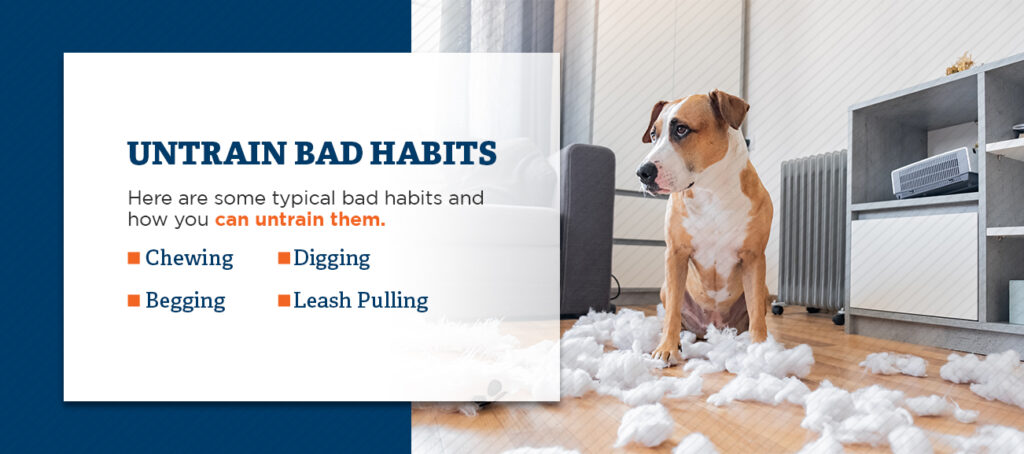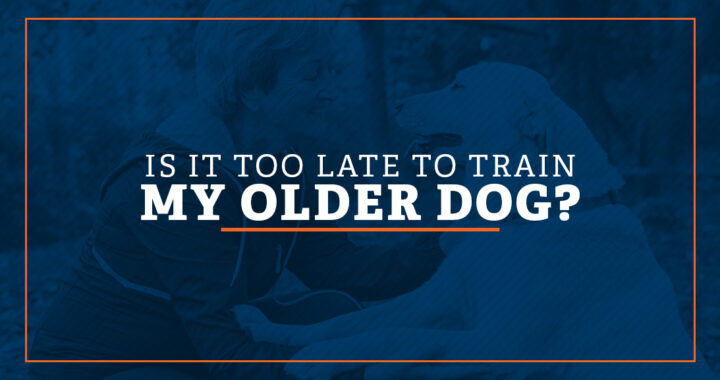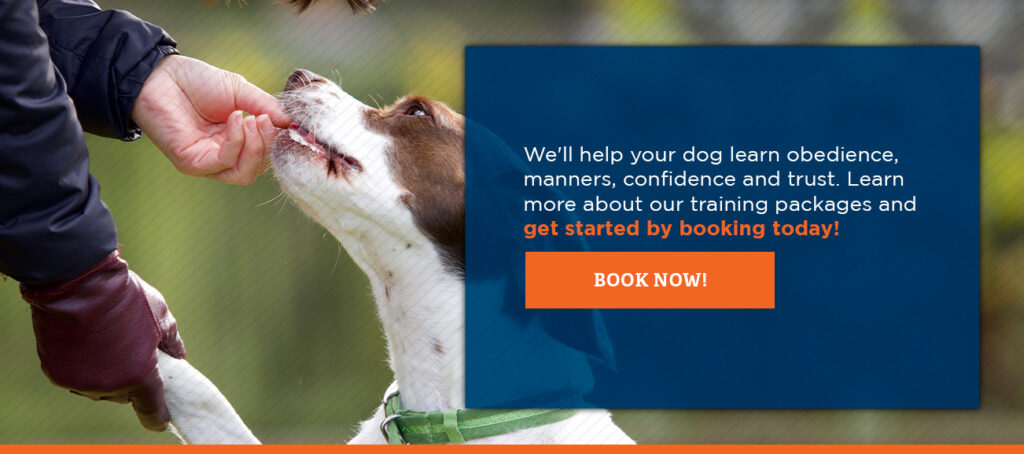If you’ve chosen to adopt a dog, chances are he’s not quite a puppy anymore. Rescuing an adult dog is a rewarding and meaningful experience, but it does present unique challenges. You may be asking yourself, “Is my dog too old to train?” Despite popular belief, you can teach an old dog new tricks. If you’re wondering when it’s too late to train a dog, the answer is never!
Training a dog as an adult can be beneficial in some ways — he may be less distractible and energetic than he was as a puppy. Not to mention, training exercises present an opportunity to bond with your dog, whether you’ve had him for years or signed adoption papers yesterday. Every dog is trainable, regardless of breed, sex, size and — yes — age.

Untrain Bad Habits
The challenging thing about training an older dog is correcting ingrained bad habits. Adult dogs who received little training as puppies always have a few unfavorable habits. Remember, negative reinforcement in the form of yelling or physical punishment will only damage your relationship with your dog and breed fear-based aggression. Instead, you can alter behavior with positive reinforcement alone. Here are some typical bad habits and how you can untrain them.
Chewing
It’s a fact of life that dogs need to chew for their oral health and to release pent-up energy. It’s a natural behavior that is not negative in and of itself. However, some dogs have a habit of destroying household items with inappropriate chewing. A dog chewing your clothes, shoes, furniture and walls can be frustrating.
To discourage destructive chewing, you’ll have to provide your dog with plenty of things that are safe and appropriate to chew. Then, you’ll need to offer positive reinforcement when your dog chews an acceptable toy, such as praise or small treats. Redirect your dog if you find him chewing on something off-limits. If inappropriate chewing continues, your dog might need more exercise or mental stimulation.
Begging
Odds are, if your dog begs, it’s because he’s gotten rewards for doing so in the past. To prevent begging, you’ll have to avoid giving in, no matter how convincing those puppy-dog eyes might be. One way to change this habit is to give your dog a long-lasting chew away from your dining area when you sit down to a meal.
Digging
Digging is another natural dog behavior. Keep in mind, digging is not usually aimless — dogs dig for a few reasons, including:
- To create a more comfortable place to rest.
- To find prey he can smell.
- To bury something.
- To curb boredom or restlessness.
Try to figure out why your dog is digging and address the root cause. If your dog is uncomfortable, create a more suitable place to relax. For example, dogs left out in the heat might dig to find cooler soil. If he’s bored, provide more exercise or stimulation. If you can, you might set aside an area where digging is acceptable, such as a sandbox.
Leash Pulling
Most dogs who lack obedience training will pull on walks, often because the dog gets where he wants to go faster when he pulls. If your dog is pulling on his leash, refuse to keep walking until the behavior stops. You should also give positive reinforcement for walking alongside you. Keep a pouch of small treats on hand when you go for a walk.
Socialization
Though socializing is ideal for younger dogs, it’s OK if you miss that opportunity. It is never too late to socialize a dog! Regular socialization builds your dog’s confidence around others, which reduces the chance of aggression. One of the best things you can do is take your dog on walks where he’ll encounter people and other dogs. Walks are the perfect time to meet someone new — your dog will have less pent-up energy and he’ll already be on a leash.
If needed, you might use a muzzle. This tool will prevent the danger of biting, and it will also keep strange people and dogs calmer during the encounter. Keeping others calm will, in turn, help relax your dog and make the whole experience more positive. Always prioritize your dog’s safety and comfort. Be patient, watch his cues and remove him from a situation if it’s causing him too much stress.
Simple Commands First
The best way to train an older dog is by starting with simple commands. Teach your dog commands that are easy to learn and build onto each other. For instance, you might teach the first few commands in this order.
1. Place
“Place” is a helpful beginning command. Create a special spot for your dog, such as a bed or crate. Gesture toward it and say “place,” prompting your dog to go there. When it’s OK for your dog to get up, you can then say “free.” Once he starts to recognize the words, you can drop the gesture.
After he has the process down, you can teach him to go to his place when he hears other sounds, such as the doorbell ringing. Remember to offer plenty of praise and a small treat each time he gets it right.
2. Sit
“Sit” is another simple command. A popular method involves “luring.” You’ll hold a treat in front of your dog’s nose and then slowly lift it above his head. As soon as his rear end touches the ground, let him have the treat. Then encourage him to stand back up so you can repeat the process. Be sure not to force your dog’s rear end to the ground, as this can be scary and confusing.
After a few successful attempts, you can remove the food lure and use your empty hand — still offer a treat after he sits. Once he understands the hand signal, add the word “sit.” After a while, you can stop gesturing and give only the verbal cue.
3. Stay
After you and your dog have mastered “sit,” you can pair it with the “stay” command. When your dog is sitting, say “stay” and hold your hand palm-out in front of you. After your dog sits still for a moment, offer a reward. Always reward your dog while he’s still in the “stay” position. A common mistake is to let the dog come to you before he gets his treat — this teaches him the reward is for coming to you, not for staying put.
Start by standing right in front of your dog and rewarding him quickly — you can gradually walk farther away and have him hold the “stay” position longer. Over time, you can add distractions like toys to make staying more challenging. This tactic will ensure your dog’s ability to stay put despite real-life distractions.
Contact Off Leash K9 Training
Of course, it’s always best to train a dog as a puppy before bad habits have a chance to set in. But if you miss the early window, it’s never too late to train your dog. You and your dog can work together to replace destructive behaviors with positive ones. Address his bad habits, help him adapt to social situations and build onto straightforward commands. In the meantime, you’ll form a strong, lifelong bond with your dog.
Given the unique challenges of training an older dog, you may find you need professional assistance. If you’re looking for dog training for older dogs, consider Off Leash K9 Training in Maryland. We offer private, one-on-one adult dog obedience training services so your dog gets the individual attention they need. We’ll help your dog learn obedience, manners, confidence and trust. Learn more about our training packages and get started by booking today


